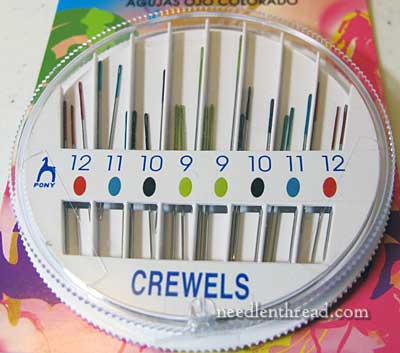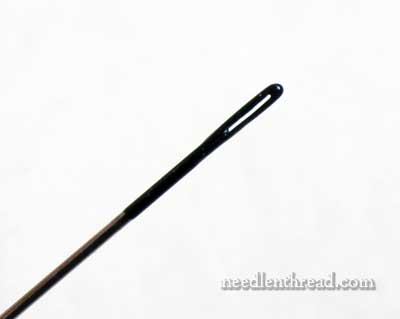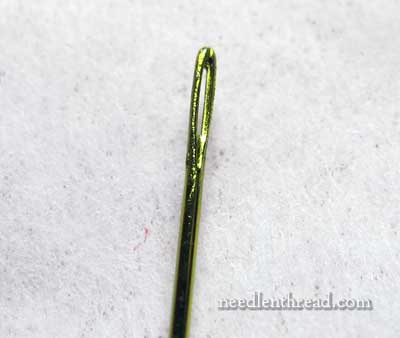A little while ago, I was asked to try a new (to me, anyway!) line of hand sewing needles from Pony.
Even though I have my favorites when it comes to embroidery needles, this doesn’t mean that I don’t use other brands. I do, and quite frequently. And I like all the needles I use, for different reasons. Believe it or not, I’m not super picky about embroidery needles, as long as they don’t have burrs and they do their job.

If you’ve ever looked around for very fine-sized embroidery or crewel needles (size numbers higher than 10), you’ve probably noticed that they’re kind of hard to come by.
There are only a few places you can buy the higher numbered embroidery needles in sizes 11 and 12. From the information I’ve been able to glean hither and yon, there are very few needle manufacturers that still make both of these sizes. I’ve found one manufacturer of “fine English needles” (whether made in England or not is another question – discussed in this article) that makes a size 12. Are there others? Maybe there are, but I haven’t been able to find them.
Pony, a needle manufacturer out of India, makes both sizes 11 and 12, and I have a little supply of them that I rely on.
When the manufacturer wrote to me a while ago to tell me about their line of colored-eye hand needles and to ask if I would like to try them, I was quite curious.
You see, what makes this new line of handwork needles from Pony different from others is the fact that the eye-ends of the needles are color-coated so that they are color-coded according to size. And when I read the description of them, my curiosity was piqued.
My first thought: How is this going to work? The color coating is going to be problematic. It will chip. It will wear off. It will interfere with the smoothness of the needle’s shaft…

You can see the color coating here. It extends about three times the length of the eye down the shaft of the needle. This particular needle is a size 10. How do I know? The coating is black. And black corresponds to size 10.

And this bright green needle? That’s a size 9.

The variety packs of crewel, chenille, and tapestry needles come in little handy dial boxes, so you can keep the needles in their separate compartments and always have the color chart on hand as long as you still have the dial box. The needles are also available in regular needle envelopes that house any particular size you want.
Pony also produces very long beading needles in this line, too.
Using the Needles
So for the past few weeks, I’ve been using these colored-eye needles from Pony, to see if my initial misgivings would bear out.
My first concern was that there would be an obvious, tangible dividing line on the needle shaft where the color begins. This, in fact, is not the case. Though you can definitely see where the color begins, you can’t feel where it begins.
Then, my primary concern was whether or not the color coating would hold up. If it were to chip or begin to wear off, it would most likely result in a rough needle surface, which is not desirable.
But, a few weeks later, I’m still using the same colored-eye needle on the Mission Rose project and the same colored-eye needle on another project, and they’re both holding up just fine. No indication of the color wearing off, no problems with burrs or anything. So far, so good!
The Mission Rose project is a good gauge, by the way. When working with filament silk on silk ground fabric, a faulty needle shows up pretty quickly.
I’m pleased with the needles so far. I’m not convinced color-coding is essential for needles, but it’s an interesting enough idea. And admittedly, it does make it really easy to differentiate a specific needle from surrounding needles. It’s pretty easy to pick out a bright green-eyed, red-eyed, or a black-eyed needle from a forest of regular needles!
I’ll keep plugging away with these needles to see how they keep up over time. So far, I’m confident they’ll be fine.
Have you tried the colored-eye needles from Pony? I haven’t seen them available here in the US anywhere, though I have seen them available on eBay (usually from the UK).







Now I’m curious how they color them without leaving an edge or having the color chip off. I suppose by the time the color does wear off, the needle may be ready for the trash bin anyway. I wonder if they make them in tapestry needles. My husband has his biscornu (that I made for him 🙂 ) with a variety of needles but then pulls one out and asks me, “Do you think this is a 24 or a 26?” Great. Do you know if these are sold in the US stores?
Hi, Irene – as mentioned above, they make tapestry, chenille, crewel, and beading needles with colored eyes. I haven’t found them in the US (online, anyway), but they may be out there somewhere…..
There are numerous ways of metal coating application, electroplating being a simple one, and as for the “edge”, there will always be one, but when that thin, they are just not “feelable” by fingers or fabric.
I have not used Pony needles but, I do like the idea of colored-eyes. I so wish I was one of those people who kept needles in their individual packets so I would know the manufacture and size. But, I am a pincushion user – old habits die hard. Often I have to pull several needles out of my pin cushion to get just the size I am looking for. Colored eyes would let me know at a glance just which one I want. Thanks for the information, I think I will give them a try!
I LOVE this! Do they make milliner’s needles like this too? I have my printed needle gauge booklet, but I can NEVER tell my needles apart. One question though–is the coating sticky or rough at all? I want to be able to make smooth bullions. Even though I don’t use crewel needles often, I am buying some definitely!!
That is a positive idea. It could be that the color aspect of it will wear off EVENTUALLY, it will just take months or years instead of just weeks. That will be something to see. Similar to the old enameled handled scissors, the color will wear off after decades, but not in a short span of time, as it seems they do now. Now they develop things cheaply, with built in obsolescence. However, since we are discussing needles, 6$-8$ (or whatever) per pack every few years is not horrible if the color wears away after a year or two of regular use for example.
I think this idea is genius! No more wondering what size needle you are using or need to find! I have several wooded cases holding needles, I would have to compare to a chart to know one from the other. With these I could just look for a color.
Deb
Dear Mary
The coloured eyed needles from Pony look interesting, colour coding what a good idea. I like the idea of the coloured eyes and the separate compartments. My problem is once I take my needles out of the packet I forget what size they are and which size packet they came from. I would find these very useful I would be able to put the right size needles in the right size compartment and therefore confusion would be a thing of the past. I like the idea of these where can I buy them?!!!
Regards Anita Simmance
Hi Mary, Ahh…a good needle…right up there with a great book to read..or wonderful new thread to try…or, being enlightened reading another terrific MC Needle ‘n Thread column. 🙂
A year or so ago, I discovered Japanese ‘Clover’ needles on the web–specifically, ‘Black Gold’ Needles. Did some research and calling, and purchased these. Totally, I am IN LOVE with these needles. They are a bit more expensive, but Oh! I am in heaven using these needles for my embroidery. My favorite is the No. 9 sharp ( my basic all-around embroidery needle), but No. 12 sharps are also sold. (lovely for thread painting) No. 12 is an ity-bity needle, but both are a dream to stitch with–pierces so smoooothly through fabric. No stabbing or pulling. Sometimes I vary and change to other recommended brands (I have a cache of needles like everyone), but gee, after a few stitches, I frown because I’m not happy, it doesn’t ‘feel right’ in my fingers and fabric, and I go back to my No. 9 Black Gold Clover needle. Happiness again!
Ok–just my 2 cents worth about favorite needles.
BTW, I love Hedgehog. Joady’s prices are most reasonable and she is a wonderful seller. I may buy these color needles from her, but….they may not get a fair workout from me. Worth a try however, and I do appreciate the info about these color needles.
Perhaps she will stock these in the future?
I really like the idea. Sewing machine needles are color coded and I have discovered that while they are still in the package it doesn’t matter, but once they are stuck into a pin cushion or needle case it can be quite difficult to tell a quilting needle from a universal needle or a jeans needle from an embroidery needle. Hand needles of different sizes have the same issues and I would like color coded needles to differentiate the sizes for needlework as well as the type of needles. I’m going to check these out. I’m glad you are not having issues with them. Thanks for your continued sharing of these great finds in the market.
lacis.com carries pony size 12 in a 25 pack for 3.20. they also carry a size I so want to try, a pony size 25 chenille needle. any experience with a size 25 chenille?
I like the idea behind the color coding and have yet to try pony brand.
Oooo, thanks, Mary. I’m going to be using quite a lot of 1 ply of the Suzhou filament silk thread, so I’ve been eyeing off the supply of #11/#12’s from Wendy Shoen, but this gives me another option. And a way of telling them apart in the pages of my needlebook.
I think this is a GREAT idea, especially for beginners like me who have no idea what size needle to use, what they’re supposed to look like, feel like, no sense for how long and big they’re supposed to be. Do they offer color coded needles larger than a 9? Say a 5 or 3 if I wanted to work with a few strands at a time?
Thanks for the review – I’ll definitely be looking for these!
Hi, Cayce – yes, they do.
These are my new favourite needles!
I bought my pony crewel and chenille needles recently and they are just wonderful. The colours make it so easy to find the right needle, the cases are very handy, and the needles glide through the fabric beautifully.
Thank you for the write-up!
Renata
I have a friend that is going blind and she loves to do hand work and I was wondering if the colored needles would help her to see her work better? If you can be of any help I would like to hear from you. thank you charlotte barkdoll
I don’t think the colored needles will help so much with threading them, but they might help her select different sizes of needles, since the needles are colored by size. I don’t know that they’d actually make the stitching easier, though. Her best bet, I think, would be a lighted magnifier.
I’m a big fan of these specific needles and I have multiple sets of them. While I did notice coating coming off on some of them after hours and hours of stitching it has never affected the way the needle itself worked. No snags etc. The only issue I ever had – is more to do with my own methodology and that is that the eye has been known to essentially twist.